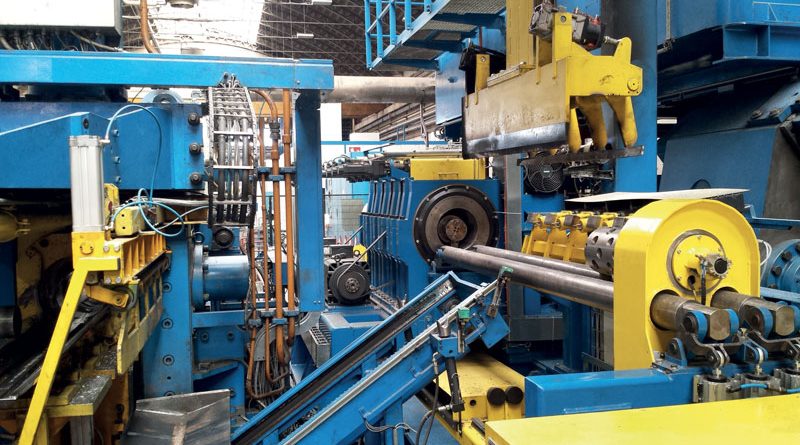High Efficiency Heating with Permanent Magnets: a Smart Way of Improving OpEx
The unique HEH (High Efficiency Heating) technology by GMS for re-heating the billets during the extrusion process
by Claudio Zanotti, GMS-Engitec Group
Pandolfo Alluminio SpA, primary operator in the aluminium extrusion business since fifty years, has continuously upgraded and expanded range of products and services, earning the reputation as a “one-stop supplier”, which sets us apart in the European market.
As GMS had the privilege of supplying Pandolfo with one HEH system the following consideration are based on the operation data collected along the period immediately after the commissioning thanks to the kind collaboration of Pandolfo. The goal of the HEH technology is to replace the existing induction heater (conventional AC induction heating system) with the new induction Permanent Magnet Heater, to prove in a concrete large-scale industrial production line, technical performance, environmental and economic benefits.
This meant to perform a number of tests with variable billet size (in the specified range), productive volumes, extrusion conditions (heating conditions) and moulds. Several tests have been repeated with different extrusion dies (the billet temperature profile is specific for each die).
All the process variables are acquired and the final quality of extruded components verified. Some Key Performance Indicators (KPI) had to be measured during or after the tests in order to quantitatively assess the performance of the new technology.
All consumption data and related analysis has been certified by CIRCE, a Spanish Research Centre for Energy Resources and Consumption.
Results
To assess the performance of HEH several KPIs, have been measured. The KPIs can be mainly subdivided in n. 5 classes respectively:
Class 1 – Indicators of process technical quality
Class 2 – Indicators of extruded quality
Class 3 – Energy performance indicators
Class 4 – Process performance indicators
Class 5 – Environmental performance indicators
In each class two or more indicators were defined to describe in the best way the different aspect involved in the line production operation condition of the permanent magnet heater.
Regarding class n. 1 (Indicators of process technical quality) 3 different indicators were defined:
1) Temperature profile in the billet after the preheating process. The target of the KPI is defined as the difference between the measured values and the temperature profile required by Pandolfo, this difference has to be comprised between ± 5 °C.
2) Extrusion speed measured during the process. The target of KPI is defined as the difference between the new and the old extrusion speed this value has to be comprised between ± 10% of old speed value.
3) Aluminium extruded outlet temperature of the steel die. The target of KPI is defined as the variation of profile temperature that has to be less than 15 °C during the extrusion.
Regarding class n. 2 (Indicators of extruded quality), 2 different indicators were defined:
1) Maintaining of correct hardness of extruded profile. The target of KPI is the percentage of scrap profile that has to be less than 0.2%.
2) Surface and section quality of extruded. The target of KPI is the percentage of scrap profile that has to be less than 0.5%.
Regarding class n. 3 (Energy performance indicators),3 different indicators were defined:
1) Input power [kW]. The target of KPI is the peak of power has to be less than the maximum power installed in the prototype [475 kW].
2) Energy consumption [kWh/ton]. The target of KPI is that the energy consumed has to be less than the energy consumed when there was the traditional AC induction heater [19.15 kWh/ton].
3) Energy efficiency [%].The target of KPI is that the efficiency has to be higher than 77% theoretical value estimated during the design phase.
Regarding class n. 4 (Process performance indicators), 1 indicator was defined:
1) Hourly productivity rate [ton/h]. The target of KPI is the average productivity has to be higher than 1.9 ton/h, value of previous year (2016).
Regarding class n. 5 (Environmental performance indicators), 2 different indicators were set to identify:
1) Carbon footprint
(kg CO2eq emissions). The KPI is identified as the saving of kg CO2 eq emissions per month. The target is to save more than 6800 kg CO2 eq. per month, value estimated during the design of the prototype.
2) Acidification potential (kg of SO2eq emissions). The KPI is defined as the saving of kg SO2 eq. emissions per month. The target is to save more than the 30 kg SO2 eq. per month, value estimated during the design of the prototype.
Conclusions
The new HEH permanent magnet heater reduces the energy consumption, generating a significant cost saving and a reduction of emissions respect the traditional Induction AC heater (Table 2).
The significant improvement in the electrical efficiency (from 50% to more than 80%) allows not only to reduce the energy cost but leads to wide environmental positive impacts as demonstrated by LC assessment carried out by Circe.

